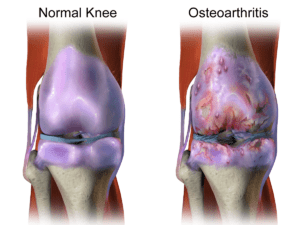Osteoarthritis
 Osteoarthritis (OA), also known as degenerative joint disease or degenerative arthritis, is the most commonly occurring chronic condition of the joints.
Osteoarthritis (OA), also known as degenerative joint disease or degenerative arthritis, is the most commonly occurring chronic condition of the joints.
A Widespread Condition
It affects more than 25 million people in the United States. While OA can affect any joint, it usually develops in the lower back and neck, hips, the bases of the big toe and thumb, and the small joints of the fingers.
Normal joints comprise a taut, rubbery substance known as cartilage, which covers the end of every bone. Cartilage provides a smooth gliding surface for the movement of the joints and creates cushioning between the bones.
OA leads to cartilage disintegration, which causes pain, swelling, and problems in joint movement. This condition worsens over time leading to the disintegration of bones and development of growths (spurs).
In the final stages of OA, the wearing of cartilage causes the bone to rub against bone. This friction leads to joint damage as well as more pain.
Board certified orthopedic surgeons at Thomas & Bigler Knee & Shoulder Institute provide treatments for the knees, shoulders and other joints to patients in Las Vegas, Nevada, and surrounding locations.
Who is Affected?
OA can develop in individuals of any age, but it most commonly occurs in people above the age of 65 years. The common risk factors for OA development are increasing age, previous joint injury, weak thigh muscles, obesity, joint overuse, and genetic predisposition.
- One in two adults will experience knee OA symptoms within their lifetime
- One in four adults will experience hip OA symptoms by the age of 85 years
- One in 12 people 60 years or above have hand OA
Treatments
Pain and Anti-inflammatory Medications
OA drugs are available as pills, syrups, creams, or lotions, or they are injected into the joint. These medications include:
Analgesics
Analgesics are pain relievers, and they comprise acetaminophen, opioids (narcotics), and an atypical opioid known as tramadol. These drugs are available OTC or by prescription.
Nonsteroidal anti-inflammatory drugs (NSAIDs)
These are the most commonly used medications to resolve inflammation and associated pain. Ibuprofen, aspirin, celecoxib, and naproxen are some common NSAIDs. These medications are available OTC or by prescription.
Corticosteroids
Corticosteroids are powerful anti-inflammatory drugs, which are either taken orally or injected directly into a joint by a medical professional.
Hyaluronic Acid
Hyaluronic acid (HA) refers to a substance that occurs naturally within the joint fluid. It is a lubricant as well as a shock absorber. However, HA seems to break down in people with OA. HA injections are administered at the physician’s office.
Physical and Occupational Therapy
Physical and occupational therapists offer various treatment options to manage the pain associated with OA, including:
- Range of motion and flexibility exercises
- Techniques to use joints properly
- Heat and cold therapies
- Assistive devices
Assistive devices provide patients with mobility and function. These devices include walkers, canes, splints, scooters, and shoe orthotics along with useful tools such as jar openers, long-handled shoe horns, or steering wheel grips.
Medical supply stores and pharmacies stock many these types of devices. But some items, such as custom knee braces and shoe wedges are prescribed by a doctor. A physical or occupational therapist helps people fit these types of items and so on.
Natural and Alternative Therapies
To enhance their well-being and for symptomatic relief, many OA patients use natural or alternative therapies. Some such therapies include massage, acupuncture or acupressure, nutritional supplements, and hydrotherapy and relaxation techniques.
Surgery
Severely compromised joints will require joint surgery to replace or repair the joint, especially knee and hip joints. A physician will refer joint surgery candidates to an orthopedic surgeon.
Board certified orthopedic surgeons Dr. Steven C. Thomas and Dr. Gregory T. Bigler, provide treatments for the knee, shoulder and other joints to patients in Las Vegas, Nevada, and surrounding communities.
If you would like to schedule an appointment or learn more about the Knee and Shoulder Institute procedures & treatments performed by Las Vegas, Nevada board-certified surgeons Steven C. Thomas, MD and Gregory T. Bigler, MD. Contact the office today click here.
